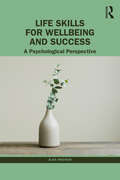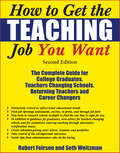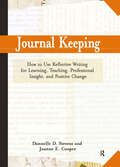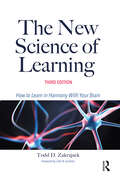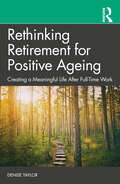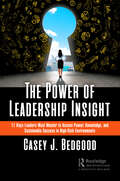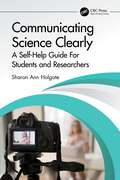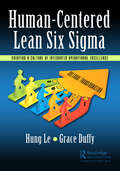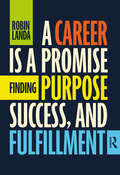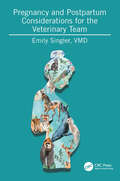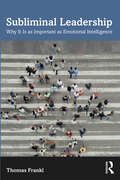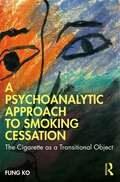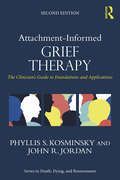- Table View
- List View
Life Skills for Wellbeing and Success: A Psychological Perspective
by Alka WadkarThis volume covers topics on awareness about one’s psychological health, management of emotions, mental hygiene, and wellbeing. It examines different types of thinking, reasoning, problem-solving, and strategies for building emotional intelligence. The book is a unique presentation of theories, research, and applications within important areas of psychology that will help the readers understand the aspects of self – emotional, cognitive, motivational, value orientation of self, and communication styles. This book shares insights into how to utilize our potential to fulfill our expectations from life with the help of positive psychological orientation. It will serve as an invaluable guide for readers interested to work on their emotional intelligence, mental health, and personal and group wellbeing, for gaining insight into developing cognitive, emotional, social, and behavioral aspects of self. It will also be of interest to students, scholars, and researchers in behavioral sciences, mental health, cognitive psychology, social psychology, counselling, philosophy, and wellness.
Life Skills for Wellbeing and Success: A Psychological Perspective
by Alka WadkarThis volume covers topics on awareness about one’s psychological health, management of emotions, mental hygiene, and wellbeing. It examines different types of thinking, reasoning, problem-solving, and strategies for building emotional intelligence. The book is a unique presentation of theories, research, and applications within important areas of psychology that will help the readers understand the aspects of self – emotional, cognitive, motivational, value orientation of self, and communication styles. This book shares insights into how to utilize our potential to fulfill our expectations from life with the help of positive psychological orientation. It will serve as an invaluable guide for readers interested to work on their emotional intelligence, mental health, and personal and group wellbeing, for gaining insight into developing cognitive, emotional, social, and behavioral aspects of self. It will also be of interest to students, scholars, and researchers in behavioral sciences, mental health, cognitive psychology, social psychology, counselling, philosophy, and wellness.
How to Get the Teaching Job You Want: The Complete Guide for College Graduates, Teachers Changing Schools, Returning Teachers and Career Changers
by Robert Feirsen Seth WeitzmanCompetition for the best teaching jobs is becoming more intense. Since publication of the first edition, when it was mainly the most desirable schools that were deluged by applications, the economic climate has made the teacher market more competitive across the board, and is changing hiring practices. Now extensively revised, this book maintains its place as the most up-to-date book available on job hunting for teachers. The authors cover changes in the educational marketplace; the new mandates about standardized testing and public reporting of student achievement–and what they mean for applicants; how new certification standards and schools’ requirements affect career changers; the growing acceptance of on-line applications and electronic portfolios; and provide additional advice for teachers applying to change schools or districts.This is also the only guide written by school administrators. Offering the insights and experience of two authors who do the hiring, it details a step-by-step program for taking charge of your teaching career. How to Get the Teaching Job You Want enables you to:* Match your unique talents to the needs of a particular school* Craft effective cover letters and resumes, using models that address the specific needs of college graduates, teachers changing schools, returning teachers and career changers* Make effective on-line applications* Leverage your achievements as an experienced teacher–or, for graduates or career changers, student teaching, substitute teaching, volunteer work or content knowledge–into a job offer* Locate jobs on-line and discover valuable information about schools, including test results, educational philosophy and names of key administrators* Design a portfolio in book or electronic format to showcase your abilities* Practice interview skills using 100 questions taken from real job interviews* Apply proven strategies for a variety of interview formats, including high stress interviews and performance interviews* Address controversial questions during interviewsThis book covers procedures for applying to elementary, middle and high schools; public, independent, and parochial schools; as well as international and boarding schools. Anecdotes recounting the experiences of real candidates looking for jobs illustrate key points. Access to the authors’ web site ensures that you will stay current in a changing job market. This is a vital book for teachers and aspiring teachers who want to achieve their career goals. It will also be invaluable for guidance counselors, psychologists, librarians and other school professionals.
Journal Keeping: How to Use Reflective Writing for Learning, Teaching, Professional Insight and Positive Change
by Dannelle D. Stevens Joanne E. Cooper** By the authors of the acclaimed Introduction to Rubrics** Major growth of interest in keeping journals or diaries for personal reflection and growth; and as a teaching tool** Will appeal to college faculty, administrators and teachers One of the most powerful ways to learn, reflect and make sense of our lives is through journal keeping. This book presents the potential uses and benefits of journals for personal and professional development—particularly for those in academic life; and demonstrates journals’ potential to foster college students’ learning, fluency and voice, and creative thinking.In professional life, a journal helps to organize, prioritize and address the many expectations of a faculty member’s or administrator’s roles. Journals are effective for developing time management skills, building problem-solving skills, fostering insight, and decreasing stress.Both writing and rereading journal entries allow the journal keeper to document thinking; to track changes and review observations; and to examine assumptions and so gain fresh perspectives and insights over past events. The authors present the background to help readers make an informed decision about the value of journals and to determine whether journals will fit appropriately with their teaching objectives or help manage their personal and professional lives. They offer insights and advice on selecting the format or formats and techniques most appropriate for the reader’s purposes.
The New Science of Learning: How to Learn in Harmony With Your Brain
by Todd D. ZakrajsekWhile preserving the elements that have made the previous two editions so successful—such as chapters on sleep, exercise, memory and mindset—this third edition introduces students to wholly new aspects of brain function and how they impact learning; and furthermore, addresses the challenges of learning online. By introducing new concepts, strategies, and applications related to learning and memory that are based on current findings in cognitive, social, and motivational psychology, this text offers a richer and more complete picture of how brain science illuminates how we learn. Students assigned this book will be equipped to design effective learning plans, employ new strategies, recognize learning traps, discover ways to work effectively in groups, improve recall, and realize better academic performance through test-taking and paper-writing strategies. This new edition also addresses the concerns of all students—particularly those unfamiliar with the college setting and its expectations and assumptions—and offers strategies for success. In keeping with the preceding editions, this book introduces students to concepts, techniques, strategies, tips, and ideas to help them be academically stronger students, advance faster in their studies, and demonstrate what they have learned more effectively—in short, how anyone can learn to be a better learner by learning how to learn in harmony with their brain. The book remains compact and student-friendly, offers examples of practice, and includes discussion questions at the end of each chapter.
How to Get the Teaching Job You Want: The Complete Guide for College Graduates, Teachers Changing Schools, Returning Teachers and Career Changers
by Robert Feirsen Seth WeitzmanCompetition for the best teaching jobs is becoming more intense. Since publication of the first edition, when it was mainly the most desirable schools that were deluged by applications, the economic climate has made the teacher market more competitive across the board, and is changing hiring practices. Now extensively revised, this book maintains its place as the most up-to-date book available on job hunting for teachers. The authors cover changes in the educational marketplace; the new mandates about standardized testing and public reporting of student achievement–and what they mean for applicants; how new certification standards and schools’ requirements affect career changers; the growing acceptance of on-line applications and electronic portfolios; and provide additional advice for teachers applying to change schools or districts.This is also the only guide written by school administrators. Offering the insights and experience of two authors who do the hiring, it details a step-by-step program for taking charge of your teaching career. How to Get the Teaching Job You Want enables you to:* Match your unique talents to the needs of a particular school* Craft effective cover letters and resumes, using models that address the specific needs of college graduates, teachers changing schools, returning teachers and career changers* Make effective on-line applications* Leverage your achievements as an experienced teacher–or, for graduates or career changers, student teaching, substitute teaching, volunteer work or content knowledge–into a job offer* Locate jobs on-line and discover valuable information about schools, including test results, educational philosophy and names of key administrators* Design a portfolio in book or electronic format to showcase your abilities* Practice interview skills using 100 questions taken from real job interviews* Apply proven strategies for a variety of interview formats, including high stress interviews and performance interviews* Address controversial questions during interviewsThis book covers procedures for applying to elementary, middle and high schools; public, independent, and parochial schools; as well as international and boarding schools. Anecdotes recounting the experiences of real candidates looking for jobs illustrate key points. Access to the authors’ web site ensures that you will stay current in a changing job market. This is a vital book for teachers and aspiring teachers who want to achieve their career goals. It will also be invaluable for guidance counselors, psychologists, librarians and other school professionals.
Journal Keeping: How to Use Reflective Writing for Learning, Teaching, Professional Insight and Positive Change
by Dannelle D. Stevens Joanne E. Cooper** By the authors of the acclaimed Introduction to Rubrics** Major growth of interest in keeping journals or diaries for personal reflection and growth; and as a teaching tool** Will appeal to college faculty, administrators and teachers One of the most powerful ways to learn, reflect and make sense of our lives is through journal keeping. This book presents the potential uses and benefits of journals for personal and professional development—particularly for those in academic life; and demonstrates journals’ potential to foster college students’ learning, fluency and voice, and creative thinking.In professional life, a journal helps to organize, prioritize and address the many expectations of a faculty member’s or administrator’s roles. Journals are effective for developing time management skills, building problem-solving skills, fostering insight, and decreasing stress.Both writing and rereading journal entries allow the journal keeper to document thinking; to track changes and review observations; and to examine assumptions and so gain fresh perspectives and insights over past events. The authors present the background to help readers make an informed decision about the value of journals and to determine whether journals will fit appropriately with their teaching objectives or help manage their personal and professional lives. They offer insights and advice on selecting the format or formats and techniques most appropriate for the reader’s purposes.
The New Science of Learning: How to Learn in Harmony With Your Brain
by Todd D. ZakrajsekWhile preserving the elements that have made the previous two editions so successful—such as chapters on sleep, exercise, memory and mindset—this third edition introduces students to wholly new aspects of brain function and how they impact learning; and furthermore, addresses the challenges of learning online. By introducing new concepts, strategies, and applications related to learning and memory that are based on current findings in cognitive, social, and motivational psychology, this text offers a richer and more complete picture of how brain science illuminates how we learn. Students assigned this book will be equipped to design effective learning plans, employ new strategies, recognize learning traps, discover ways to work effectively in groups, improve recall, and realize better academic performance through test-taking and paper-writing strategies. This new edition also addresses the concerns of all students—particularly those unfamiliar with the college setting and its expectations and assumptions—and offers strategies for success. In keeping with the preceding editions, this book introduces students to concepts, techniques, strategies, tips, and ideas to help them be academically stronger students, advance faster in their studies, and demonstrate what they have learned more effectively—in short, how anyone can learn to be a better learner by learning how to learn in harmony with their brain. The book remains compact and student-friendly, offers examples of practice, and includes discussion questions at the end of each chapter.
Rethinking Retirement for Positive Ageing: Creating a Meaningful Life After Full-Time Work
by Denise TaylorRethinking Retirement for Positive Ageing is a practical guide that shows you how to make retirement successful, based on the most up-to-date research available. It encourages a deeper and wider view of retirement and reveals how retirement can be a time of transition, renewal, and re-imagination. Written by career coach Dr Denise Taylor, it considers the psychological factors that impact a successful adjustment to retirement and offers a deeper analysis of how people can find meaning and purpose after full-time work. It examines retirement as an event that often brings about great changes in a person’s personal and social life, and how to move forward with meaning in life. Illustrated with interviews, activities, and case studies, and with exercises and questions for reflection, it covers key topics including identity, health, well-being, finances, and relationships. This insightful guidebook is for all prospective and current retirees as well as employers, careers professionals, and counsellors who want to help people reflect on their approaches to retirement. You can visit the website at https://denisetaylor.co.uk/rethinking-retirement/
Rethinking Retirement for Positive Ageing: Creating a Meaningful Life After Full-Time Work
by Denise TaylorRethinking Retirement for Positive Ageing is a practical guide that shows you how to make retirement successful, based on the most up-to-date research available. It encourages a deeper and wider view of retirement and reveals how retirement can be a time of transition, renewal, and re-imagination. Written by career coach Dr Denise Taylor, it considers the psychological factors that impact a successful adjustment to retirement and offers a deeper analysis of how people can find meaning and purpose after full-time work. It examines retirement as an event that often brings about great changes in a person’s personal and social life, and how to move forward with meaning in life. Illustrated with interviews, activities, and case studies, and with exercises and questions for reflection, it covers key topics including identity, health, well-being, finances, and relationships. This insightful guidebook is for all prospective and current retirees as well as employers, careers professionals, and counsellors who want to help people reflect on their approaches to retirement. You can visit the website at https://denisetaylor.co.uk/rethinking-retirement/
The Power of Leadership Insight: 11 Keys Leaders Must Master to Access Power, Knowledge, and Sustainable Success in High-Risk Environments
by Casey J. BedgoodLeadership is a risky business. In the current world, change is the new normal and only constant. As change grows, so does risk. Thus, leaders must be master change agents and master mitigators of risk. But, how will leaders succeed if they don’t measure and lack insight? Simply put, they won’t. Those that are successful in these arenas will ride the waves of success during their tenure on the leadership stage. In contrast, their counterparts will be crushed by the never-ending waves of disruption. Often leaders or those aspiring erroneously view leadership power from a self-interested perspective. They see power through the lens of a title, position, control over others, influence, emotional intelligence and the like. Unfortunately, this view is misaligned and short sighted. Another perspective of leadership is the ability to impact positive change for those around you. In reality, leaders are those that use their gifts, skills and knowledge to educate and empower others in the long run. The purpose of this book is to unveil insight as to the true meaning of leadership power – how to attain it, how to leverage it to add the greatest amount of value to humanity, how to weaponize it to marginalize and eliminate risk and how to share it with others so they can carry the torch once you step off the leadership stage. In this book, readers will learn: How to master the art of change The value of leadership self-advocacy The pearls and pitfalls of leading integration teams The unintended consequences of sharing knowledge The sidewinder effect of misinterpreting root causes of success The leadership test of humility Leadership matchmaking to ensure the right leaders are selected to solve the organization’s problems Leadership Loopholes: The Houdini Effect The risk of underestimating leadership value The risk of not focusing on the right attributes The risk of leading turnarounds
The Power of Leadership Insight: 11 Keys Leaders Must Master to Access Power, Knowledge, and Sustainable Success in High-Risk Environments
by Casey J. BedgoodLeadership is a risky business. In the current world, change is the new normal and only constant. As change grows, so does risk. Thus, leaders must be master change agents and master mitigators of risk. But, how will leaders succeed if they don’t measure and lack insight? Simply put, they won’t. Those that are successful in these arenas will ride the waves of success during their tenure on the leadership stage. In contrast, their counterparts will be crushed by the never-ending waves of disruption. Often leaders or those aspiring erroneously view leadership power from a self-interested perspective. They see power through the lens of a title, position, control over others, influence, emotional intelligence and the like. Unfortunately, this view is misaligned and short sighted. Another perspective of leadership is the ability to impact positive change for those around you. In reality, leaders are those that use their gifts, skills and knowledge to educate and empower others in the long run. The purpose of this book is to unveil insight as to the true meaning of leadership power – how to attain it, how to leverage it to add the greatest amount of value to humanity, how to weaponize it to marginalize and eliminate risk and how to share it with others so they can carry the torch once you step off the leadership stage. In this book, readers will learn: How to master the art of change The value of leadership self-advocacy The pearls and pitfalls of leading integration teams The unintended consequences of sharing knowledge The sidewinder effect of misinterpreting root causes of success The leadership test of humility Leadership matchmaking to ensure the right leaders are selected to solve the organization’s problems Leadership Loopholes: The Houdini Effect The risk of underestimating leadership value The risk of not focusing on the right attributes The risk of leading turnarounds
Communicating Science Clearly: A Self-Help Guide For Students and Researchers
by Sharon Ann HolgateThis unique self-help guide equips undergraduates, postgraduate students, and early career researchers within the sciences with transferrable communication skills that they can adapt and refer back to as they progress through their careers. It provides practical guidance on how to best communicate science in a range of different settings. This book facilitates clear and concise communication in both academic scenarios and the workplace. It covers settings ranging from job interviews, through conference presentations, to explaining your research to the general public. It is illustrated with first-hand experiences, top tips, and "dos and don’ts" to demonstrate best practices. It will also be a valuable guide for established academics who would like a refresher or a guide to new avenues of science communication, such as podcasts. Key Features: Written by an award-winning professional science journalist and broadcaster with 25 years’ experience, including writing for national newspapers, devising and presenting programmes for BBC Radio 4, and being interviewed on radio, TV, video, and podcasts Covers science communication in a broad range of settings including peer-to-peer, to your manager, at job interviews, and during media appearances Includes advice from a range of experts who communicate professionally, including a radio producer, a TV presenter, actors and entertainers, and scientists Additional video material to accompany this book can be found here: https://www.youtube.com/playlist?list=PLLUWyRwmgFlW7_NrNupeuiJ86OxIWHZ6I. Sharon Ann Holgate is a freelance science writer and broadcaster. She has presented on BBC Radio 4 and the BBC World Service, and presented video podcasts for medical research charity the Myrovlytis Trust. She earned a D.Phil in physics from the University of Sussex, where she was a Visiting Fellow in Physics and Astronomy for nine years. Her articles have appeared in Science, Science Careers, New Scientist, The Times Higher Education Supplement, The Times Literary Supplement, Flipside, E&T, Focus, Physics World, Interactions, Materials World, Modern Astronomer, and Astronomy Now. She was also shortlisted for the radio programme category of the Association of British Science Writers' Awards in 2005, and for the Aventis Prizes for Science Books Junior Prize in 2003. Dr. Holgate was the recipient of the Institute of Physics 2022 William Thomson, Lord Kelvin Medal and Prize for communicating science to a wide variety of audiences and for positive representations of scientists from non-traditional backgrounds. She has also received the Institute of Physics Young Professional Physicist of the Year Award and a Merit Award in the Daily Telegraph Young Science Writer of the Year competition. She is the author of the undergraduate textbook Understanding Solid State Physics, which is currently in its second edition and used as a core text in universities around the world.
Communicating Science Clearly: A Self-Help Guide For Students and Researchers
by Sharon Ann HolgateThis unique self-help guide equips undergraduates, postgraduate students, and early career researchers within the sciences with transferrable communication skills that they can adapt and refer back to as they progress through their careers. It provides practical guidance on how to best communicate science in a range of different settings. This book facilitates clear and concise communication in both academic scenarios and the workplace. It covers settings ranging from job interviews, through conference presentations, to explaining your research to the general public. It is illustrated with first-hand experiences, top tips, and "dos and don’ts" to demonstrate best practices. It will also be a valuable guide for established academics who would like a refresher or a guide to new avenues of science communication, such as podcasts. Key Features: Written by an award-winning professional science journalist and broadcaster with 25 years’ experience, including writing for national newspapers, devising and presenting programmes for BBC Radio 4, and being interviewed on radio, TV, video, and podcasts Covers science communication in a broad range of settings including peer-to-peer, to your manager, at job interviews, and during media appearances Includes advice from a range of experts who communicate professionally, including a radio producer, a TV presenter, actors and entertainers, and scientists Additional video material to accompany this book can be found here: https://www.youtube.com/playlist?list=PLLUWyRwmgFlW7_NrNupeuiJ86OxIWHZ6I. Sharon Ann Holgate is a freelance science writer and broadcaster. She has presented on BBC Radio 4 and the BBC World Service, and presented video podcasts for medical research charity the Myrovlytis Trust. She earned a D.Phil in physics from the University of Sussex, where she was a Visiting Fellow in Physics and Astronomy for nine years. Her articles have appeared in Science, Science Careers, New Scientist, The Times Higher Education Supplement, The Times Literary Supplement, Flipside, E&T, Focus, Physics World, Interactions, Materials World, Modern Astronomer, and Astronomy Now. She was also shortlisted for the radio programme category of the Association of British Science Writers' Awards in 2005, and for the Aventis Prizes for Science Books Junior Prize in 2003. Dr. Holgate was the recipient of the Institute of Physics 2022 William Thomson, Lord Kelvin Medal and Prize for communicating science to a wide variety of audiences and for positive representations of scientists from non-traditional backgrounds. She has also received the Institute of Physics Young Professional Physicist of the Year Award and a Merit Award in the Daily Telegraph Young Science Writer of the Year competition. She is the author of the undergraduate textbook Understanding Solid State Physics, which is currently in its second edition and used as a core text in universities around the world.
Human-Centered Lean Six Sigma: Creating a Culture of Integrated Operational Excellence
by Hung Le Grace DuffyThis book focuses on the human side of organizational culture. The authors approach organizational culture from the perspective of alignment to mission, vision, and values. Using a Lean Six Sigma structure, the sequence of chapters begins with the organization and its structure, then drills through strategic, operational, and tactical levels of process and behavior which establish and grow the overall culture of the organization over time. The book begins with foundational principles of organization, through the necessity of aligning processes and systems to mission and vision, assessment, gap analysis for improvement, prioritization, and chapters on qualitative and quantitative approaches for reducing variation and improving systems and behavior. Through this book, readers will: Learn the foundation and core concepts of the organization Discover the "right" focus of shifting the culture of the organization Recognize the building blocks of organizational culture and how to integrate them into a successful, customer-focused system of interconnected processes Focus on people as drivers of technology, rather than the reverse Explore techniques to address the challenges and concerns of today’s training and deployment for organizational performance excellence Use the chapters as short discussions or training workshops for either internal education or public/private technical education.
Human-Centered Lean Six Sigma: Creating a Culture of Integrated Operational Excellence
by Hung Le Grace DuffyThis book focuses on the human side of organizational culture. The authors approach organizational culture from the perspective of alignment to mission, vision, and values. Using a Lean Six Sigma structure, the sequence of chapters begins with the organization and its structure, then drills through strategic, operational, and tactical levels of process and behavior which establish and grow the overall culture of the organization over time. The book begins with foundational principles of organization, through the necessity of aligning processes and systems to mission and vision, assessment, gap analysis for improvement, prioritization, and chapters on qualitative and quantitative approaches for reducing variation and improving systems and behavior. Through this book, readers will: Learn the foundation and core concepts of the organization Discover the "right" focus of shifting the culture of the organization Recognize the building blocks of organizational culture and how to integrate them into a successful, customer-focused system of interconnected processes Focus on people as drivers of technology, rather than the reverse Explore techniques to address the challenges and concerns of today’s training and deployment for organizational performance excellence Use the chapters as short discussions or training workshops for either internal education or public/private technical education.
A Career Is a Promise: Finding Purpose, Success, and Fulfillment
by Robin LandaNo matter your field of interest, A Career is a Promise offers a proven framework for finding purpose, fulfillment, and success. Robin Landa, one of the world's leading experts on creativity and idea generation, reveals practical strategies that will help you identify a career worthy of your intelligence, aptitudes, and time. Much more than a how-to guide, the roadmaps, prompts, inner directed questions, and self-assessment tools will help you discover what most excites you professionally, how to set worthwhile career goals, find purpose in your career, achieve success, lead with compassion, find fulfillment, secure mentors and sponsors, and enhance your creative thinking to best compete in a global marketplace. Most of us don’t spend adequate time thinking about what ignites our souls and makes careers roar–well enough to forge a fruitful and satisfying career path. When you spend more than one third of your life working, your career should hold promise. A career is a promise you make to yourself.
A Career Is a Promise: Finding Purpose, Success, and Fulfillment
by Robin LandaNo matter your field of interest, A Career is a Promise offers a proven framework for finding purpose, fulfillment, and success. Robin Landa, one of the world's leading experts on creativity and idea generation, reveals practical strategies that will help you identify a career worthy of your intelligence, aptitudes, and time. Much more than a how-to guide, the roadmaps, prompts, inner directed questions, and self-assessment tools will help you discover what most excites you professionally, how to set worthwhile career goals, find purpose in your career, achieve success, lead with compassion, find fulfillment, secure mentors and sponsors, and enhance your creative thinking to best compete in a global marketplace. Most of us don’t spend adequate time thinking about what ignites our souls and makes careers roar–well enough to forge a fruitful and satisfying career path. When you spend more than one third of your life working, your career should hold promise. A career is a promise you make to yourself.
Pregnancy and Postpartum Considerations for the Veterinary Team
by Emily SinglerPrecautions often apply to pregnancy in any workplace, but being a vet in practice presents additional specific risks. There are concerns and uncertainty about potential hazards, from radiation and inhalant anesthesia exposure, to zoonoses, and the additional mental stress in a profession that already carries high suicide risk. This book reviews considerations for professionals in clinical veterinary medicine (large and small animal) while pregnant and after giving birth. Veterinarian and veterinary writer, consultant, and mentor Dr Emily Singler speaks directly to veterinary team members (veterinarians, technicians, CSRs, assistants, students) who are pregnant or plan to become pregnant. She delivers scientific information on the specific risks to the mother and baby that may be encountered during pregnancy while working in veterinary medicine, with some of her own and others’ experiences to add perspective and humor. The book also covers topics related to mental health challenges, announcing a pregnancy and planning for parental leave, navigating the fourth trimester, and returning to work. We hope that having read this book, veterinary professionals – whether pregnant or working with pregnant colleagues – will feel better supported and empowered to make informed decisions.
Pregnancy and Postpartum Considerations for the Veterinary Team
by Emily SinglerPrecautions often apply to pregnancy in any workplace, but being a vet in practice presents additional specific risks. There are concerns and uncertainty about potential hazards, from radiation and inhalant anesthesia exposure, to zoonoses, and the additional mental stress in a profession that already carries high suicide risk. This book reviews considerations for professionals in clinical veterinary medicine (large and small animal) while pregnant and after giving birth. Veterinarian and veterinary writer, consultant, and mentor Dr Emily Singler speaks directly to veterinary team members (veterinarians, technicians, CSRs, assistants, students) who are pregnant or plan to become pregnant. She delivers scientific information on the specific risks to the mother and baby that may be encountered during pregnancy while working in veterinary medicine, with some of her own and others’ experiences to add perspective and humor. The book also covers topics related to mental health challenges, announcing a pregnancy and planning for parental leave, navigating the fourth trimester, and returning to work. We hope that having read this book, veterinary professionals – whether pregnant or working with pregnant colleagues – will feel better supported and empowered to make informed decisions.
Subliminal Leadership: Why It Is as Important as Emotional Intelligence
by Thomas FranklUnderstanding the power of subliminal influence makes or breaks leaders. What is it that subliminally motivates people to give their best, not just what’s in their job description? How do you build an outstanding team? (Spoiler: it’s not just by putting the best people in a team.) The answer lies in the power of subliminal influence. This book explains in a clear and accessible way this important, yet little known and understood, area of psychology and leadership. As Emotional Intelligence helped managers and leaders to understand the importance of empathy in the workplace, Subliminal Leadership takes us to the next level by explaining how influence through non-verbal communication mostly happens below the threshold of our conscious awareness: subliminal forms of body language and communication which influence other people's attitudes, thinking and behavior – and which may boost, or undermine a leader's authority, the performance of teams or the quality of key customer relationships. Readers will learn how we unconsciously communicate and how we positively or negatively influence other people in the process. Understanding subliminal influence will help people in, or aspiring towards, leadership positions to build trust, understand others’ emotions, make better decisions, and strengthen professional relationships. Based on recent scientific research in disciplines as diverse as psychology, evolutionary biology, anthropology, medicine, neuroscience, and management studies, the book offers a breakthrough, multidisciplinary approach to influence and leadership. This book is for everyone interested in the psychological, biological, and medical dimensions of leadership.
Subliminal Leadership: Why It Is as Important as Emotional Intelligence
by Thomas FranklUnderstanding the power of subliminal influence makes or breaks leaders. What is it that subliminally motivates people to give their best, not just what’s in their job description? How do you build an outstanding team? (Spoiler: it’s not just by putting the best people in a team.) The answer lies in the power of subliminal influence. This book explains in a clear and accessible way this important, yet little known and understood, area of psychology and leadership. As Emotional Intelligence helped managers and leaders to understand the importance of empathy in the workplace, Subliminal Leadership takes us to the next level by explaining how influence through non-verbal communication mostly happens below the threshold of our conscious awareness: subliminal forms of body language and communication which influence other people's attitudes, thinking and behavior – and which may boost, or undermine a leader's authority, the performance of teams or the quality of key customer relationships. Readers will learn how we unconsciously communicate and how we positively or negatively influence other people in the process. Understanding subliminal influence will help people in, or aspiring towards, leadership positions to build trust, understand others’ emotions, make better decisions, and strengthen professional relationships. Based on recent scientific research in disciplines as diverse as psychology, evolutionary biology, anthropology, medicine, neuroscience, and management studies, the book offers a breakthrough, multidisciplinary approach to influence and leadership. This book is for everyone interested in the psychological, biological, and medical dimensions of leadership.
A Psychoanalytic Approach to Smoking Cessation: The Cigarette as a Transitional Object
by Fung KoA Psychoanalytic Approach to Smoking Cessation: The Cigarette as a Transitional Object provides an accessible understanding to the unconscious motive behind smoking addiction using Winnicott’s concept of the transitional object. The book is divided thematically into six parts. Ko begins by outlining the conscious motives for smoking from a psychological perspective and looks at commercial research conducted by the tobacco industry, before using psychoanalytically informed cross-disciplinary literature to assess the unconscious motives for smoking. She expertly introduces Winnicott’s view on smoking addiction, using his concept of the transitional object, and highlights the power of the Free Association Narrative Interview method in accessing the unconscious and embedded emotional experiences. Using clinical examples, she illustrates the benefits of this method as a tool to elicit free associations from research respondents. She details the parallels between the individual respondents’ smoking experience, as well as their relationship with cigarettes and the seven qualities of transitional objects outlined by Winnicott in his 1953 landmark paper. Ko concludes by emphasising the significance and implications of this thesis to smokers and public health policy, as well as the smoking cessation approach and proposed directions for future research. This book is an essential resource for psychoanalysts and psychotherapists working in smoking cessation organisations, as well as those working in addiction services.
A Psychoanalytic Approach to Smoking Cessation: The Cigarette as a Transitional Object
by Fung KoA Psychoanalytic Approach to Smoking Cessation: The Cigarette as a Transitional Object provides an accessible understanding to the unconscious motive behind smoking addiction using Winnicott’s concept of the transitional object. The book is divided thematically into six parts. Ko begins by outlining the conscious motives for smoking from a psychological perspective and looks at commercial research conducted by the tobacco industry, before using psychoanalytically informed cross-disciplinary literature to assess the unconscious motives for smoking. She expertly introduces Winnicott’s view on smoking addiction, using his concept of the transitional object, and highlights the power of the Free Association Narrative Interview method in accessing the unconscious and embedded emotional experiences. Using clinical examples, she illustrates the benefits of this method as a tool to elicit free associations from research respondents. She details the parallels between the individual respondents’ smoking experience, as well as their relationship with cigarettes and the seven qualities of transitional objects outlined by Winnicott in his 1953 landmark paper. Ko concludes by emphasising the significance and implications of this thesis to smokers and public health policy, as well as the smoking cessation approach and proposed directions for future research. This book is an essential resource for psychoanalysts and psychotherapists working in smoking cessation organisations, as well as those working in addiction services.
Attachment-Informed Grief Therapy: The Clinician’s Guide to Foundations and Applications (Series in Death, Dying, and Bereavement)
by Phyllis S. Kosminsky John R. JordanAttachment-Informed Grief Therapy bridges the fields of attachment studies, thanatology, and interpersonal neuroscience, uniting theory, research, and practice to enrich our understanding of how we can help the bereaved. The new edition includes updated research and discussion of emotion regulation, relational trauma, epistemic trust, and much more. In these pages, clinicians and students will gain a new understanding of the etiology of problematic grief and its treatment, and will become better equipped to formulate accurate and specific case conceptualization and treatment plans. The authors also illustrate the ways in which the therapeutic relationship is crucially important – though largely unrecognized – element in grief therapy and offer guidelines for an attachment-informed view of the therapeutic relationship that can serve as the foundation of all grief therapy. Written by two highly experienced grief counselors, this volume is filled with instructive case vignettes and useful techniques that offer a universal and practical frame of reference for understanding grief therapy for clinicians of every theoretical persuasion.
